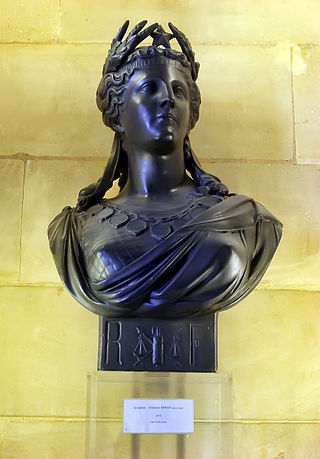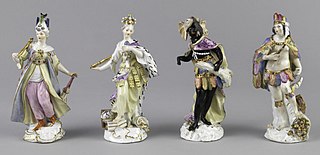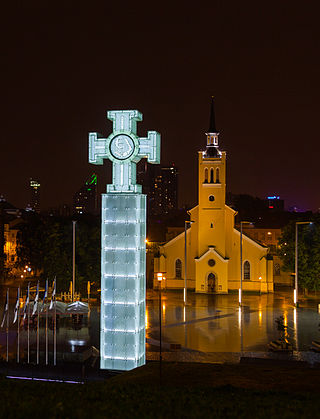
Hungaria is a national personification of Hungary, an allegory and a personification of the nation.
Contents


The Lady of Hungaria is displayed in many places in Hungary and across its borders. She symbolizes the liberty of Hungary.

Hungaria is a national personification of Hungary, an allegory and a personification of the nation.


The Lady of Hungaria is displayed in many places in Hungary and across its borders. She symbolizes the liberty of Hungary.
After the decades of the lost revolution and independence war of 1848/49 the Habsburg monarchy went into absolutism. In the 1860s, monuments were raised to commemorate the lost liberty. One of these depictions was the Lady of Hungaria. She is often symbolised as a woman with a helmet or the Holy Crown of Hungary on her head, and a sword and shield in her hands. At Arad where the 13 martyrs of independence war were executed, a huge monument was raised in 1889. The central figurine is Hungaria.
After the Treaty of Trianon and the loss of lives after World War I, the lady became the symbol for hope and the resurrection of Hungary.

The Statue of Liberty is a colossal neoclassical sculpture on Liberty Island in New York Harbor in New York City, in the United States. The copper statue, a gift from the people of France, was designed by French sculptor Frédéric Auguste Bartholdi and its metal framework was built by Gustave Eiffel. The statue was dedicated on October 28, 1886.

Libertas is the Roman goddess and personification of liberty. She became a politicised figure in the Late Republic, featured on coins supporting the populares faction, and later those of the assassins of Julius Caesar. Nonetheless, she sometimes appears on coins from the imperial period, such as Galba's "Freedom of the People" coins during his short reign after the death of Nero. She is usually portrayed with two accoutrements: the rod and the soft pileus, which she holds out, rather than wears.
Hungaria or Hungária may refer to:

The Phrygian cap or liberty cap is a soft conical cap with the apex bent over, associated in antiquity with several peoples in Eastern Europe and Anatolia, including the Persians, the Medes and the Scythians, as well as in the Balkans, Dacia, Thrace and in Phrygia, where the name originated. The oldest depiction of the Phrygian cap is from Persepolis in Iran.

Marianne has been the national personification of the French Republic since the French Revolution, as a personification of liberty, equality, fraternity and reason, as well as a portrayal of the Goddess of Liberty.

The concept of liberty has frequently been represented by personifications, often loosely shown as a female classical goddess. Examples include Marianne, the national personification of the French Republic and its values of Liberté, Égalité, Fraternité, the female Liberty portrayed on United States coins for well over a century, and many others. These descend from images on ancient Roman coins of the Roman goddess Libertas and from various developments from the Renaissance onwards. The Dutch Maiden was among the first, re-introducing the cap of liberty on a liberty pole featured in many types of image, though not using the Phrygian cap style that became conventional. The 1886 Statue of Liberty by Frédéric Auguste Bartholdi is a well-known example in art, a gift from France to the United States.

A war memorial is a building, monument, statue, or other edifice to celebrate a war or victory, or to commemorate those who died or were injured in a war.

A monument is a type of structure that was explicitly created to commemorate a person or event, or which has become relevant to a social group as a part of their remembrance of historic times or cultural heritage, due to its artistic, historical, political, technical or architectural importance. Some of the first monuments were dolmens or menhirs, megalithic constructions built for religious or funerary purposes. Examples of monuments include statues, (war) memorials, historical buildings, archaeological sites, and cultural assets. If there is a public interest in its preservation, a monument can for example be listed as a UNESCO World Heritage Site.

A liberty pole is a wooden pole, or sometimes spear or lance, surmounted by a "cap of liberty", mostly of the Phrygian cap. The symbol originated in the immediate aftermath of the assassination of the Roman dictator Julius Caesar by a group of Rome's Senators in 44 BCE. Immediately after Caesar was killed the assassins, or Liberatores as they called themselves, went through the streets with their bloody weapons held up, one carrying a pileus carried on the tip of a spear. This symbolized that the Roman people had been freed from the rule of Caesar, which the assassins claimed had become a tyranny because it overstepped the authority of the Senate and thus betrayed the Republic.

Columbia, also known as Miss Columbia, is a female national personification of the United States. It was also a historical name applied to the Americas and to the New World. The association has given rise to the names of many American places, objects, institutions and companies, including the District of Columbia; Columbia, South Carolina; Columbia University; "Hail, Columbia"; Columbia Rediviva; and the Columbia River. Images of the Statue of Liberty largely displaced personified Columbia as the female symbol of the United States by around 1920, although Lady Liberty was seen as an aspect of Columbia. Columbia's most prominent display today is as part of the logo of the Hollywood film studio Columbia Pictures.

The Great Seal of the State of South Carolina was adopted in 1776. South Carolina's seal is made up of two elliptical areas, linked by branches of the palmetto tree. The image on the left is dominated by a tall palmetto tree and an oak tree, fallen and broken. This scene represents the battle fought on June 28, 1776, between defenders of the unfinished fort on Sullivan's Island, and the British Fleet. The standing palmetto represents the victorious defenders, and the fallen oak is the British Fleet. Banded together on the palmetto with the motto Quis separabit?, are 12 spears that represent the other original 12 states of the Union. Beneath that is enscrolled another of the alternate state mottoes, "Meliorem Lapsa Locavit" with the date of 1776. Surrounding the image, at the top, is "South Carolina", and below, is Animis opibusque parati. The other image on the seal depicts the Roman goddess Spes walking along a shore that is littered with weapons. The goddess grasps a branch of laurel as the sun rises behind her. Below her image is her name, Spes, Latin for 'hope', and over the image is the motto Dum spiro spero, meaning 'While I breathe, I hope'.
The Daughters of Liberty was the formal female association that was formed in 1765 to protest the Stamp Act, and later the Townshend Acts, and was a general term for women who identified themselves as fighting for liberty during the American Revolution.

Personification is the representation of a thing or abstraction as a person. In the arts, many things are commonly personified. These include numerous types of places, especially cities, countries, and continents, elements of the natural world such as the months or four seasons, four elements, four cardinal winds, five senses, and abstractions such as virtues, especially the four cardinal virtues and seven deadly sins, the nine Muses, or death.

The Liberty Statue or Freedom Statue is a monument on the Gellért Hill in Budapest, Hungary. It commemorates those who sacrificed their lives for the independence, freedom, and prosperity of Hungary.

The Dutch Maiden is a national personification of the Netherlands. She is typically depicted wearing a Roman garment and with a lion, the Leo Belgicus, by her side. In addition to the symbol of a national maiden, there were also symbolic provincial maidens and town maidens.

Uncle Sam is a common national personification of the federal government of the United States or the country in general. Since the early 19th century, Uncle Sam has been a popular symbol of the U.S. government in American culture and a manifestation of patriotic emotion. Uncle Sam has also developed notoriety for his appearance in military propaganda, popularized by a famous 1917 World War I recruiting poster by J.M. Flagg.

Lady Justice is an allegorical personification of the moral force in judicial systems. Her attributes are scales, a sword and sometimes a blindfold. She often appears as a pair with Prudentia.

The Cross of Liberty and the Monument to the War of Independence is located in Freedom Square, Tallinn, Estonia. It was opened on 23 June 2009 as a memorial for those who fell during the Estonian War of Independence, through which the people of Estonia will be able to commemorate all those who had fought for freedom and independence. The pillar is 23.5 m high and consists of 143 glass plates. The memorial incorporates the Cross of Liberty, Estonia's most distinguished award established in 1919.

Mother Serbia, Serb Mother or Mother of All Serbs, is a female national personification of Serbia, which is the nation-state of Serbs.

Mother Croatia is the female personification of Croatia and a national emblem of the nation.